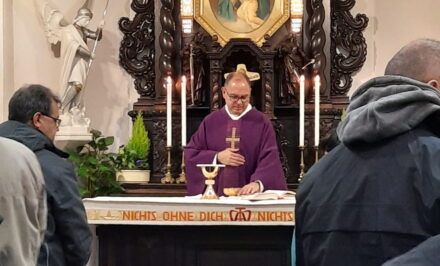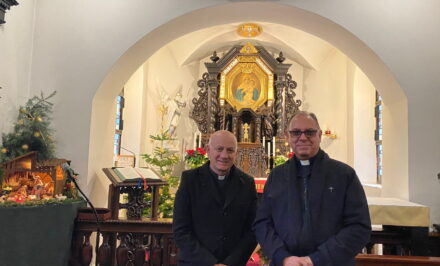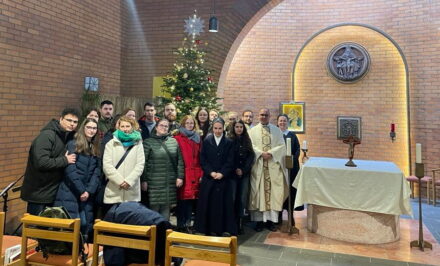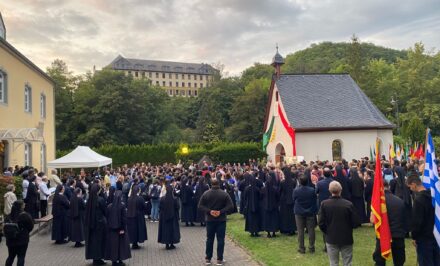 Agathe Hug. The month of May is the month of gifts. A great gift was the return of Fr Kentenich on 20 May 1945 from Dachau. Vice versa, the month of Mary is the month of giving gifts to the Blessed Mother.
Agathe Hug. The month of May is the month of gifts. A great gift was the return of Fr Kentenich on 20 May 1945 from Dachau. Vice versa, the month of Mary is the month of giving gifts to the Blessed Mother.
20 May 1947
The women’s Institute of our Lady of Schoenstatt donated a new light frame made of precious metal and precious stones as their gift for the Blessed Mother’s crowning.
31 May 1948
The Women’s League donated a new tabernacle as their crowning gift. The five silver plates lining the inner surfaces of the tabernacle were added the following year on 31 May 1949.
And of course, May Blossoms and the Capital of Grace

12 May 1915
In a letter to Josef Fischer Fr Kentenich mentioned the “capital of grace” for the first time. He wrote,
“However, we are also happy about our little chapel and feel more at home there than before. You should also be at home there. Of course, you will receive a large interest payment from the capital of grace we are collecting here in May, on condition that you contribute something to the capital in your own way. You understand me…”
It is interesting to note that according to Fr Menningen’s testimony the concept capital of grace originated during a conversation with Fr Kentenich, and began to be used without those who used it knowing about the Founding Document of 18 October 1914, or with reference to it. Today we consider it natural that people know about the Founding Document and that they can connect the capital of grace with the Founding Document. However, we are dealing with May 1915, that is, exactly seven months after the Founding Document. That talk was totally unknown. It had not been printed, nor was it generally available. At that time the internet did not exist to enable a rapid transfer of information.
“Fr Menningen on the Concept “Capital of Grace”
“Fr Eise, Max Brunner, Albert Langner, Fr Wilwers and others have become the representatives of the Sodality devotion to Mary, but not the Founding Document of 18 October 1914. The mystery of the Founding Document first broke through in the soul of Joseph Engling through the contributions to the capital of grace of the MTA, so that the chapel could become a shrine.
We asked Fr Kentenich: “How did the concept ‘capital of grace’ originate? Did you have the Founding Document in mind when you mentioned the ‘capital of grace’ in your letter to Fischer?”
Fr Kentenich replied: “No, it was far more Grignion’s devotion that led us to the capital of grace. At the time Grignion’s devotion had captured the hearts, and according to it you have to collect merits and offer them to the Blessed Mother for others. So this devotion was more likely the inspiration for the idea of the capital of grace.”
Our next question was: “How did the expression ‘capital of grace’ come up? How did you hit on it?”
His answer: “When you look back, you no longer know. The expression was only mentioned in passing in the letter to Fischer. My only guess is Grignion’s devotion to Mary.”
Another question I asked Fr Kentenich: “In his preparation for the vacations in July 1915, how could Joseph Engling arrive at the motto: Daily schedule during the vacations as contributions to the capital of grace of the Mater ter admirabilis, to prevail on the Blessed Mother to take possession of the chapel, then it will become a place of grace?” His answer: “I can’t remember a definite event, or that I said something like that in a talk; I also can’t remember that I suggested the idea of the capital of grace in a talk. The only possibility is that the idea was mentioned in passing as a suggestion during a discussion with Joseph Engling. This would have been in connection with Grignion’s devotion to Mary. This then got stuck in Joseph Engling’s soul and grew to become the above practice.” Joseph Engling made it into what might be called a system: The daily spiritual schedule as contributions to the capital of grace, which we transfer into the shrine.
This is how the spiritual current of contributions to the capital of grace originated. It was a breakthrough of the Founding Document although we did not know the name of the talk given on 18 October 1914. This was only discovered later. Joseph Engling did not know it …”
We can prove that Fr Kentenich did not take over the concept, “capital of grace”, from anyone or any source, at any rate it does not come from a written source. In 1970 Fr Menningen described what happened.
Until now we have only come across the concept ‘capital of grace’ in three places in Church literature, that is, with Alphonse Liguori, Tanquerey and Scheeben, but Fr Kentenich did not know any of these sources. Alphonse and Tanquery wrote in Italian, Scheeben lived much later, and, according to Fr Kentenich’s testimony, he had not yet read his works.“
May 1915
The Sodalists collected May Blossoms for the Blessed Mother, selecting their resolutions from a cardboard box on the altar in the little chapel.
May 1916
May Blossoms were again collected.
There are two reports about their May Blossoms. There are not only informative, but also great fun to read. According to Fr Menningen, the collection of May Blossoms prepared the ground for the capital of grace.
1915 – The Cardboard Box on the Altar in the Shrine
There are two reports that show how already in May 1915, and also later, a cardboard box (or even two cardboard boxes) stood on the altar in the shrine. They had a special role to play.
The first report is drawn from Fr Alex Meinningen’s reminiscences. At the same time as the Mission Association was transformed into the Marian Sodality for the senior boys, the Senior, and the Junior section of the Marian Sodality arose for the younger boys from the Educational Association in the third class, Alex Menningen was one of the youngest boys in the first class. Much later he became Fr Alex Menningen, who was so important in Schoenstatt. He was one of Fr Kentenich’s closest co-workers. He entered the College boarding school in September 1913 as a member of the first class. He could only observe from a distance what the older boys were doing in their Association.
Even before the First World War broke out 2 August 1914 everything changed. On 31 July 1914 the directors of the boarding school sent the boys home. On 4 August the College was taken over by the military and turned into a field hospital. As a result, not all the boys were able to return to Schoenstatt after the summer vacation of 1914. The two most junior classes had unwillingly to take an extraordinarily long summer vacation from July. Government propaganda spread the expectation that the war would quickly come to an end with the victory of the German army, then life would continue as before. However, this never happened. So the school heads decided to re-start the school before the end of the war. The senior classes were able to return in October; the junior classes only returned on 11 November, although not to Schoenstatt, but to the old college in Ehrenbreitstein. This is where the young Alex, along with 60 other boys, spent the first part of the second school year until Easter 1915.
When Alex returned to Schoenstatt after Easter 1915, he was surprised to see the changes that had taken place there. Later he repeatedly recounted what he had observed.
Alex Menningen was amazed by many things, and above all by the Chapel of St Michael, the Sodality Chapel. The senior boys were zealous in visiting it. In particular he observed something important, which he talked about in 1970, for example.
The second report comes down to us from the memories of Alfons Weber. He later became a Pallottine Father and spent the largest part of his life in Argentina. He related many things from the past, and once again mentioned that small box in which it seemed that self-education, devotion to Mary and the community work of the Marian Sodality converged.
When he wrote his memories he was 68. It was obvious that a number of details had impressed him deeply. A comparison with the list of May Blossoms, which originated a year later, that is, in 1916, suggests itself. The original document has been preserved and is at present in the archive of the Schoenstatt Fathers.
Source: www.urheiligtum.de – historical research of Fr Heinrich Hug
Translation from the German: Mary Cole, Bolton, England













